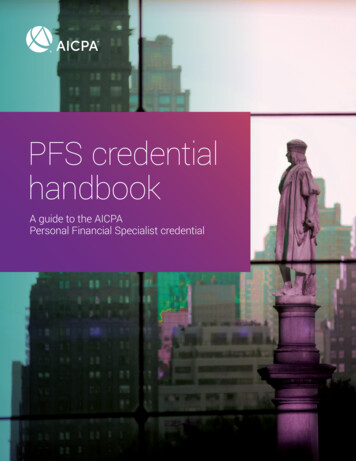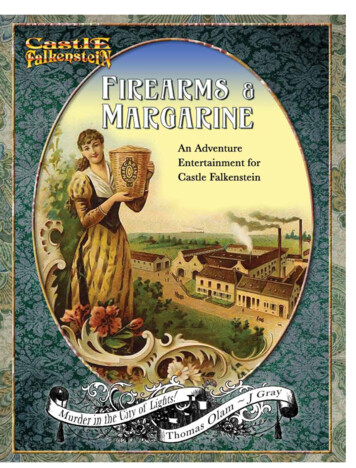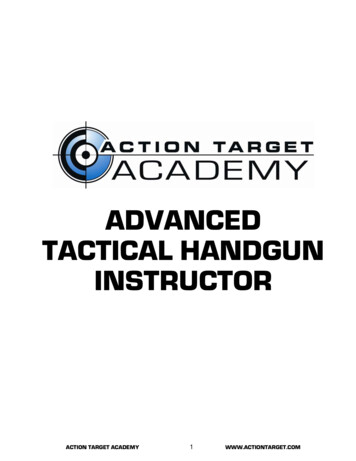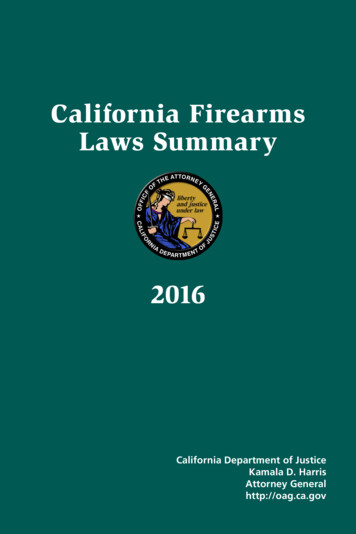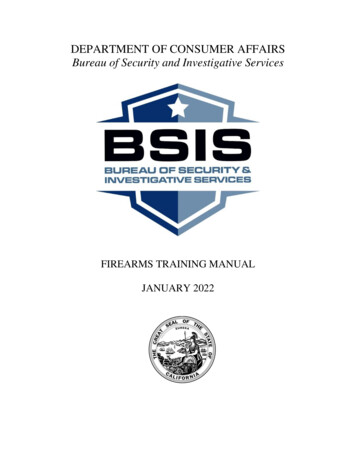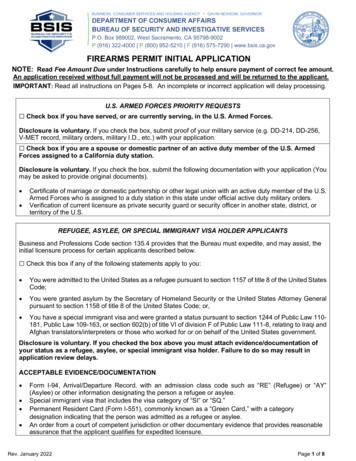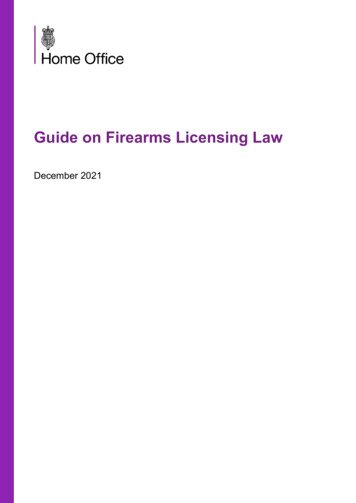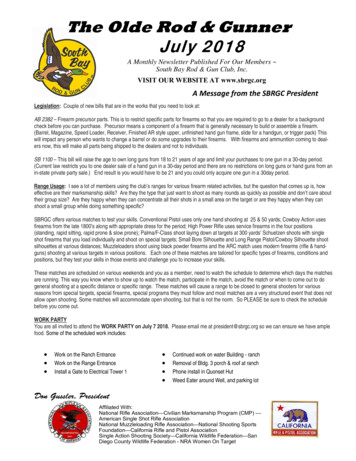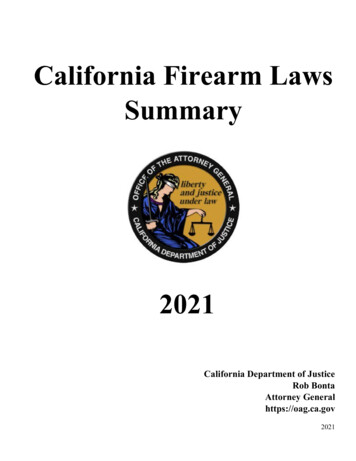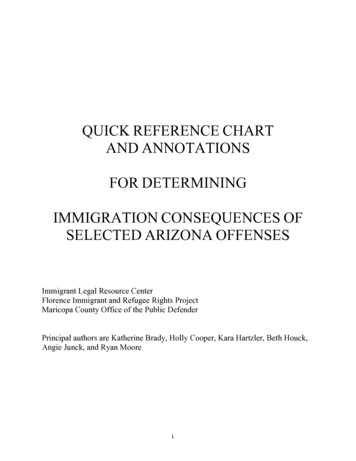![Firearms Qualifications [PFP#730045656]](/img/59/firearms2003.jpg)
Transcription
Firearms QualificationSemi-Annual Firearms Qualification and Requalification Standards for New Jersey LawEnforcementIssued December 1989Revised September 1990Revised April 1998Revised April 2001Revised June 2003TO:Law Enforcement ExecutivesFROM:Vaughn L. McKoyActing DirectorDATE:June 26, 2003SUBJECT:FIREARMS QUALIFICATION AND REQUALIFICATIONSTANDARDS FOR NEW JERSEY LAW ENFORCEMENTRecent firearms deployment changes in the law enforcement community, new firearmstechnology and thoughtful review of present policy have necessitated the amendment of theFirearms Qualification And Requalification Standards For New Jersey Law Enforcement, lastupdated in April 2001. After consultation with the New Jersey law enforcement firearmsinstructors community, the following changes have been incorporated in this edition of theStandards: The handgun night qualification course has been completely revised. The new courseof fire replaces long, sustained strings of fire with more duty relevant testing, includingthe mandated use of handheld or gun-mounted lights. In addition, the minimumqualification score has been increased from 70% to 80% which parallels the requirementfor daylight qualification. The recent problem with black bears in New Jersey has brought back the shotgun sluginto the law enforcement arsenal. Agencies deploying the slugs requested guidance inthe training and qualification of their personnel with this shotgun ammunition.Therefore, a "Shotgun Slug Qualification Course" (SSQC) has been developed forqualification under both daylight and night firing conditions. As with the traditional "OOBuck" ammunition, qualification will be required semi-annually. Recent technology has given birth to a new class of firearm referred to as the "PersonalDefense Weapon" (PDW). Developed for military personnel assigned to confinedareas, this firearm resembles a submachine gun in size and a rifle in performance.Several New Jersey law enforcement agencies are considering the purchase of this typeof weapon. In the law enforcement community this type of weapon would be deployed16/2003
as a subgun, however, since the ammunition is fired at rifle-defined velocities, agenciesare confused as to training and qualification requirements. Therefore, a new class offirearm, "Personal Defense Weapon" (PDW), has been added to the policy to definethe firearm itself and its place in training and qualification. The PDW will be considereda submachine gun and all personnel utilizing such firearms will follow the subgunprotocol for training and qualification. In addition, slight procedural changes were madeto the Subgun Qualification Course to accommodate the widening variety of subgunsbeing manufactured and deployed. A slight change was made to the Scoped Rifle Qualification Course regarding the timerequirements at the 100 & 50 yard lines, shooting position at the 50 yard line as well asan adjustment to the qualification target.The complete, updated Firearms Qualification And Requalification Standards For NewJersey Law Enforcement can be found at the Division of Criminal Justice's web site,www.njdcj.org.These changes may be adopted as soon as possible, and become mandatory effectiveJanuary 1, 2004.If you have any questions concerning firearms qualification standards please call theDivision of Criminal Justice State Range Master at (973) 599-5946.26/2003
TO:LAW ENFORCEMENT EXECUTIVESFROM:WAYNE S. FISHER, PH.D.DEPUTY DIRECTORDATE:MAY 21, 2001SUBJECT:FIREARMS QUALIFICATION AND REQUALIFICATIONSTANDARDS FOR NEW JERSEY LAW ENFORCEMENTRevisions have been made to the Firearms Qualification and Requalification Standardsfor New Jersey Law Enforcement. The changes are the result of recommendations and reviewby many rangemasters and firearms instructors throughout the state. Revisions have beenmade in the courses of fire for handgun, subgun, service rifle and carbine qualification. Inaddition, a quailfing course of fire has been developed for scoped rifles. The statewidequalification protocol now includes standards for the entire range of firearms carried by lawenforcement officers in the conduct of routine duties and specialized operation. Of particularnote is an increase in the number of qualification sessions required for shotguns.Requalification will be required twice a year with any weapon carried on a regular basis as partof an officer’s equipment for performance of routine official duties.Increases in the number of requalification sessions required per year for specifiedfirearms, as well as modifications in the course of fire, will be effective January 1, 2002. Policeexecutives are encouraged, however, to augment their agency requalification proceduresconsistent with the attached revised standards at any time prior to that date.If you have any questions concerning firearms qualification standards please call theDivision of Criminal Justice State Rangemaster at (973) 599-594636/2003
TO:ALL LAW ENFORCEMENT OFFICERSDATE:December 1, 1989SUBJECT:Semi-Annual Firearms Qualification and Requalification Standards forNew Jersey Law EnforcementIn compliance with the instructions of Attorney General Peter N. Perretti, Jr. andpursuant to the Criminal Justice Act of 1970, N.J.S.A. 52:17B-97 et seq., effectiveJanuary 1, 1991 it is directed that all New Jersey law enforcement officers shall followthe attached Semi-Annual Firearms Qualification and Requalification Standards, and allNew Jersey law enforcement agencies shall adopt such standards as agency policy.The Attorney General's directive dated July 17, 1985 did not provide forspecialized training with respect to automatic and semi-automatic assault weapons.Accordingly, all law enforcement officers who are authorized to use such weapons shallcomply with the provisions of this manual concerning automatic and semi-automaticassault weapons commencing March 1, 1990.Robert T. WinterDirector, Division of Criminal Justice9-4Revised (05/03)
TO:ALL LAW ENFORCEMENT CHIEF EXECUTIVESSUBJECT:Semi-Annual Firearms Qualification and Requalification Standards forNew Jersey Law EnforcementFollowing is the revised directive requiring all law enforcement officers tosatisfactorily complete designated firearms qualification courses so that they maycontinue to lawfully carry a firearm in the State of New Jersey. This directive will beeffective January 1, 1991.The previously issued directive, dated June 17, 1985, mandated semi-annualfirearms requalification, provided an explanation of Tennessee v. Garner and outlinedthe firearms requalification program. That program included requirements forrequalification with both service and off-duty weapons, along with requirements forsystematic record keeping of qualifying scores.The Semi-Annual Firearms Qualification and Requalification Manual, whichaccompanies the revised directive, provides the approved training and qualificationrequirements for law enforcement personnel exempt from the provisions of N.J.S.A.2C:39-5. These requirements are necessary to meet the mandates of N.J.S.A.2C:39-6J. Subsection J, which became effective on March 17, 1986, provides in part:A person shall qualify for an exemption from the provisionsof N.J.S.A. 2C:39-5, .if the person has satisfactorilycompleted a firearms training course approved by the PoliceTraining Commission. Such exempt person shall notpossess or carry a firearm until the person has satisfactorilycompleted a firearms training course and shall annuallyqualify in the use of a revolver or similar weapon.This new directive and accompanying manual augment the original directive andprovisions of N.J.S.A. 2C:39-6J by incorporating minimum standards for semi-annualfirearms qualification. This directive and qualification procedures shall be implementedby all New Jersey law enforcement agencies. The system of firearms qualification to beimplemented is designed to measure basic firearms skills using uniform standards.The manual includes: standards for firearms qualification for revolvers,semi-automatic handguns and shotguns, as well as automatic and semi-automaticassault-type weapons. The manual also includes training guidelines, proceduresregarding non-qualifying participants, record keeping and reporting procedures, andrequirements for firearms instructors.Officers must continue to qualify twice annually following the procedures and9-5Revised (5/03)
Semi-Annual Firearms Qualification and Requalification Standardsrequirements contained in the manual. These procedures do not prevent individualagencies from conducting additional in-service firearms training. Agencies areencouraged to conduct supplemental training to meet the special needs of theirpersonnel.I therefore direct, as a matter of law enforcement policy, that effective January 1,1991 all officers must meet the minimum standards set forth in the Semi-AnnualFirearms Qualification and Requalification Manual. Those personnel who do notsuccessfully qualify or requalify with firearms shall not be permitted to carry firearms.This directive is being issued to ensure the safety of law enforcement officers aswell as promote the public safety and ensure a high level of public confidence in thecompetence and integrity of our law enforcement personnel in the performance of theirofficial functions. This directive is to be distributed to and adopted by all lawenforcement personnel within the state.Robert Del TufoAttorney General9-6Revised (5/03)
Semi-Annual Firearms Qualification and Requalification StandardsHANDGUN AND SHOTGUN QUALIFICATIONAND REQUALIFICATIONSection 1. General ProvisionsApplicability: This policy applies to all law enforcement personnel in New Jerseyeffective March 1, 2001.Supersession Notice: This policy supersedes the Attorney General's Directive ofDecember, 1998 and replaces those portions of the 21 county policies currently inplace, as indicated in this policy.Summary: This policy delineates the Attorney General's requirements on firearmsrequalification by establishing standards for the conduct of semi-annual firearmsrequalification and associated training.Purpose: This policy is intended to establish a uniform set of standards forsemi-annual firearms requalification for any weapon, including a shotgun, which isissued or authorized for use both on and off duty. It identifies specific courses of firethat meet firearm requalification requirements. It identifies the minimum score andtraining necessary to meet the requalification standards as set forth in this manual.On June 17, 1985, the Attorney General issued a directive requiring that all lawenforcement personnel requalify with their firearms at least twice a year pursuant toplans submitted to and approved by the county prosecutor. This directive retains thetwice a year requalification standard, augments the minimum standard now set forth inN.J.S.A. 2C:39-6J, and establishes a set of standards and requirements forrequalification.Law enforcement personnel must, therefore, continue to qualify twice annuallypursuant to this policy and to their respective county plans not affected or covered bythis policy. This policy is directed by the Attorney General, through the Division ofCriminal Justice.Section 2. DefinitionsThe following words and terms, when used in this manual, shall have thefollowing meanings unless the context clearly indicates otherwise.9-7Revised (5/03)
Semi-Annual Firearms Qualification and Requalification StandardsAmmunition.Equivalent load. Ammunition used in training programs that resembles theservice load in size, weight, velocity, recoil and trajectory, but not carried as a dutyround.Service load. Ammunition authorized by the agency and issued for duty use.Chief or Agency Executive. The chief executive officer of any law enforcementagency in New Jersey.Firearms Instructor. An individual who is certified by the Police Training Commissionto instruct firearms in a basic recruit training program or possesses equivalent trainingas outlined in Section 6 of this manual.Firearms Record. A record of firearms qualification activities for each officer requiredto participate. A record is to be completed, and maintained chronologically, each timethe officer is required to qualify or requalify on a firearm. The record shall includerelevant firearms data (make, model, caliber and serial number), training andqualification, location, date of qualification activities, qualification courses completed,ammunition used, scores fired, name of the supervising firearms instructor, and otherpertinent information.First Aider. This is a certified member of a volunteer first aid squad, a person certifiedas a first responder or emergency medical technician, or someone who is otherwiseadequately trained in first aid.Handgun. A firearm (semi-automatic or revolver) designed so that it can be held andfired with one hand.Handgun Qualification Courses (HQC1 or HQC2). Standardized courses of fire forsemi-annual handgun qualification for service and off-duty handguns. (Appendices Aand B).Handgun Night Qualification Course (HNQC). A standard course of fire under nightfiring conditions for semi-annual qualification for service and off-duty handguns.(Appendix C).Law Enforcement Agency. Any police force or organization of a municipality, countyor state which has, by statute or ordinance, the responsibility of detecting crime andenforcing the general laws of the state.9-8Revised (5/03)
Semi-Annual Firearms Qualification and Requalification StandardsNight Firing Conditions. Low light conditions either under natural subdued lighting orutilizing simulated subdued lighting.Non-Qualifying Participant. A person who fails to achieve a minimum passing scorewhile firing a prescribed qualification course.Participant. An individual undergoing semi-annual firearms qualification.Qualification Score--Handgun. A score of 80% or higher based on one firing of aHandgun Qualification Course (either HQC1 or HQC2) as contained in Appendices Aand B.Qualification Score--Handgun Night Firing. A score of 80% or higher based on onefiring of the Handgun Night Qualification Course (HNQC) as contained in Appendix C.Qualification Score--Shotgun. A score of 80% or higher based on one firing of theShotgun Qualification Course (SQC) as contained in Appendix D.Qualification Score--Shotgun Night Firing. A score of 80% or higher based on onefiring under subdued lighting conditions of the Shotgun Night Qualification Course(SNQC) as contained in Appendix D.Qualification Score - Shotgun Slug. A score of 80% or higher based on one firing ofthe Shotgun Slug Qualification Course (SSQC) as contained in Appendix D1.Qualification Score - Shotgun Slug Night Firing. A score of 80% or higher based onone firing under subdued light conditions of the Shotgun Slug Qualification Course(SSQC) as contained in Appendix D1.Semi-Annual Qualification. A program consisting of two prescribed qualificationsessions within a 12-month period (a calendar year), with at least three months timebetween each qualification. The program is to include semi-annual qualification withhandguns and semi-annual qualification with the agency authorized shotgun utilizingstandardized courses of fire under daylight and night firing conditions.Shotgun. A smooth bore firearm that is specifically designed and capable of firingshotgun cartridges.Shotgun Qualification Course (SQC). A standard course of fire for semi-annualqualification for shotguns as prescribed in this manual. (Appendix D).Shotgun Night Qualification Course (SNQC). A standard course of fire under9-9Revised (5/03)
Semi-Annual Firearms Qualification and Requalification Standardssubdued light conditions for semi-annual qualification for shotguns as prescribed in thismanual. (Appendix D).Shotgun Slug Qualification course (SSQC). A standard course of fire for semiannual qualification both day and under subdued light conditions utilizing shotgun slugs.(Appendix D1).Supervising Firearms Instructor. An individual designated by the chief or agencyexecutive to conduct firearms qualification and supervise the firearms instructors andparticipants during firearms qualifications activities. The supervising firearms instructormust satisfy the requirements of a firearms instructor and must have experience inconducting either a PTC-approved firearms course or an equivalent course.Training/Qualification Schedule. Firearms training schedules that become part of thefirearms records reflecting the personnel, dates and times of semi-annual qualificationactivities.Section 3. Responsibilities1.2.3.Division of Criminal Justice: To establish a system of compliance, provide oversight for thispolicy and assist in implementing the policy statewide. To provide all necessary and reasonable assistance to lawenforcement agencies affected by this policy.County Prosecutor: To implement the Attorney General's policy on firearmsqualification within the county jurisdiction, including reviewingqualification programs conducted by law enforcement agencieswithin the respective county jurisdiction for consistency withstatewide standards, conducting qualification programs as required,and maintaining proper records. To provide assistance to agencies within the county jurisdiction toenable them to conduct training and qualification programs inaccordance with the standards established within this policy.State, County and Municipal Law Enforcement Agencies:9-10Revised (5/03)
Semi-Annual Firearms Qualification and Requalification Standards To schedule and conduct individual semi-annual firearmsqualification programs as directed by this policy. To maintain proper records as they relate to firearms qualificationof agency personnel. To take appropriate action with participants who fail to qualify. Thisaction is to be determined by the agency chief executive. To immediately notify the county prosecutor, or in the case ofcertain state agencies the Division of Criminal Justice, of thoseparticipants who fail to qualify with a service weapon. To report annually to the county prosecutor, or in the case ofcertain state agencies the Division of Criminal Justice, concerningqualification activities conducted during the year. (See Section 10.Records and Reports). Every police agency within a county willreport to the prosecutor of that county. To ensure compliance with the standards contained in this policy.Section 4. Agency Training and Qualification Requirements To conform to the requirements of N.J.S.A. 2C:39-6. To conduct semi-annual firearms qualification programs inconformance with the standards set forth in this manual. To qualify, twice annually, on a Handgun Qualification Course(either HQC1 or HQC2) with a minimum score of 80% with theservice handgun. (See Appendices A or B for courses of fire). To qualify, twice annually, on a Handgun Qualification Course(either HQC1 or HQC2) with a minimum score of 80% with any offduty handgun which has been determined by the agency executiveor supervisory firearms instructor to be substantially different indesign, function or caliber from the service handgun. (If an off-dutyhandgun does not differ substantially in design, function, or caliberfrom the service handgun, a separate qualification with this weaponis at the discretion of the agency executive). To qualify, under night firing conditions, twice annually, on the9-11Revised (5/03)
Semi-Annual Firearms Qualification and Requalification StandardsHandgun Night Qualification Course (HNQC) with a score of 80%with the service handgun. (See Appendix C for course of fire). To qualify twice annually, under night firing conditions, on theHandgun Night Qualification Course (HNQC) with a minimum scoreof 80% with any off-duty handgun which has been determined bythe agency executive or supervising firearms instructor to besubstantially different in design, function or caliber from the servicehandgun. (If an off-duty handgun does not differ substantially indesign, function or caliber from the service handgun, a separatequalification with this weapon is at the discretion of the agencyexecutive.) To qualify those officers who are or might be assigned use of anagency issued shotgun twice annually on both the ShotgunQualification Course (SQC) and the Shotgun Night QualificationCourse (SNQC) with a score of 80% using the agency authorizedshotgun. To qualify those officers who are or might be assigned use of theagency issued shotgun utilizing slug ammunition twice annually,both in daylight and under subdued light conditions, on the ShotgunSlug Qualification Course (SSQC) with a minimum score of 80%using the agency authorized shotgun. To provide remedial training for those personnel who do not meetthe standards of qualification or take appropriate action until suchtime as the qualification standards are met. To train, on a semi-annual basis, all personnel in the use of force,including an update in all state, county and agency policies,statutes, and court decisions dealing with the use of force. To review semi-annually all firearms policies as they relate to:1.2.3.4.5.6.7.8.Warning shotsMoving vehiclesRemoval of firearm from holster or display of firearmsSurrender of firearmDisposal of animalsCarrying of weapons, on and off dutyConsumption of alcohol, use of prescription drugsCovert operations9-12Revised (5/03)
Semi-Annual Firearms Qualification and Requalification Standards To review semi-annually all relevant state, and municipalprocedures for reporting the accidental or intentional discharge of afirearm while on or off duty, except those fired intraining/requalification. To develop and review semi-annually agency policies, rules andregulations defining:1.2.3.4. Official firearms and service ammunitionOff-duty firearmsService ammunitionLeather gear, to include loading devices for service andoff-duty firearms.To provide agency personnel with appropriate training forspecialized weapons such as rifles and other tactical weapons.Section 5. Qualification ProgramQualification. Qualification and requalification is required both during daylight hoursand under night firing conditions. All qualification sessions must be conducted underthe supervision of a qualified supervising firearms instructor.Courses of Fire. Only those courses listed in this manual are to be used to meet theindividual firearms qualification requirements set forth by this policy. Additional coursesof fire and training programs may be included in the agency schedule for firearmstraining. The purpose of this program is not to prevent agencies from engaging insupplemental training courses that meet their special needs. Specialty training isencouraged.Handgun Qualification Courses (HQC1 and HQC2). (See Appendices A andB). A Handgun Qualification Course must be completed two times a year forservice handguns and for handguns authorized for use off duty and which aredetermined to be substantially different in design, function or caliber from theservice handgun. This determination is to be made by the agency executive orsupervising firearms instructor. Either course, HQC1 or HQC2, may be selectedfor qualification purposes.If an off-duty handgun does not differ substantially in design, function or caliberfrom the service handgun, a separate qualification with this weapon, under eitherdaytime or nighttime conditions, is at the discretion of the agency executive.9-13Revised (5/03)
Semi-Annual Firearms Qualification and Requalification StandardsHandgun Night Qualification Course (HNQC). (See Appendix C). TheHandgun Night Qualification Course is to be completed two times a year forservice handguns and for handguns authorized for use off duty and which aredetermined to be substantially different in design, function or caliber from theservice handgun. This determination is to be made by the agency executive orsupervising firearms instructor. Either course, HQC1 or HQC2, may be selectedfor qualification purposes.If an off-duty handgun does not differ substantially in design, function or caliberfrom the service handgun, a separate qualification with this weapon, under eitherdaytime or nighttime conditions, is at the discretion of the agency executive.Shotgun Qualification Course (SQC). (See Appendix D). The ShotgunQualification Course is to be conducted semi-annually for the agency issued andapproved shotgun.Shotgun Night Qualification Course (SNQC). (See Appendix D). The ShotgunNight Qualification Course is to be conducted semi-annually for the agency issued andapproved shotgun.Shotgun Slug Qualification course (SSQC). (See Appendix D1). A standardcourse of fire for semi-annual qualification both day and under subdued lightconditions utilizing shotgun slugs.Participants should be advised of what is required for each course of fire andshould be provided with a copy of each course of fire and training program before goingto the range.Supervising Firearms Instructor. The agency chief executive officer shall designatea supervising firearms instructor for each qualification session conducted.Firearms Instructor. Proper instructor-participant ratios should be maintained duringqualification sessions. (See Section 7. Supervising/Firearms InstructorResponsibilities).Ammunition. Each participant shall be provided with service or equivalent loads forqualification with agency or department issued firearms.Firearms. Qualification shall be conducted with a handgun approved by theparticipant's agency. Shotgun qualification shall be conducted with the agencyapproved shotgun.Before any firearm is used, the supervising firearms instructor (or designee) shall9-14Revised (5/03)
Semi-Annual Firearms Qualification and Requalification Standardsinspect and approve the firearm. Approval of a firearm shall be based on department oragency standards. The process of approving the service handgun, off-duty handgun orshotgun shall be governed by the agency or department policy. A copy of records ofapproval shall be kept on file by the agency or department. Any off-duty handgundetermined to be similar to the agency's service handgun and, therefore, not fired forqualification must be presented to the supervising firearms instructor (or designee) forinspection during each of the agency's qualification periods.If a firearm is determined not to be serviceable, either prior to or during its use,the supervising firearms instructor shall not allow the firearm to be used. Thesupervising instructor shall require the agency or department or the individual, in thecase of an off-duty weapon, to furnish a serviceable replacement. A report must befiled by the supervising instructor with the agency or department indicating why thefirearm was unserviceable and what action was taken to correct the problem.Equipment. Each participant, prior to undergoing firearms qualification, must beequipped with the agency authorized belt, holster, magazines, loading device and bulletloops. The qualification course will be fired only with the use of agency authorizedloading devices and equipment. This will be indicated on the qualification record formand training schedule. Ear protection is mandatory and eye protection is stronglyrecommended for all live-fire activity.Clothing. Each participant should complete courses of fire wearing clothing similar tothat worn while on duty. Uniformed and plain clothes personnel should wear theappropriate clothing and all equipment required in their respective assignments.Indoor Ranges. Agencies may utilize indoor ranges to meet the requirements of thispolicy.Range Conduct. Qualification on ranges will be conducted in accordance with therequirements listed in this policy.Section 6. Firearms Instructor Qualification RequirementsAll instructors (supervising firearms instructors and firearms instructors) engagedin the prescribed semi-annual firearms requalification program must satisfy one of thefollowing requirements. An instructor must be certified by the Police Training Commission (PTC)to instruct firearms in an approved "Basic Course" as defined in N.J.A.C.13:1-1.1.9-15Revised (5/03)
Semi-Annual Firearms Qualification and Requalification Standards An instructor must possess training equivalent to the PTC-approvedfirearms instructor course and be able to demonstrate knowledge and skillin this field. Equivalent training includes successful completion of afirearms instructor training program such as offered by the Federal Bureauof Investigation, United States Secret Service, Federal Law EnforcementTraining Center at Glynco, GA., New Jersey State Police, Smith andWesson Academy or the National Rifle Association Police FirearmsInstructor Program. An instructor must have satisfactorily completed some other recognizedfirearms instructor course as determined by the chief of police or agencyexecutive.Supervising firearms instructors must also have experience in conducting eithera PTC-approved firearms course or an equivalent course.Section 7. Supervising/Firearms Instructor ResponsibilitiesThe supervising firearms instructor is responsible for: Conducting firearms activities in accordance with the standards set forthin this manual. Ensuring the safety of all individuals engaged in firearms activities.Complying with all requirements set forth in this policy and manual withrespect to all participants involved in qualification activities and training. Ensuring proper firearms instructor-participant ratios at all times on thefiring line. The following ratios are recommended:1.2.3. One firearms instructor for six participants using handguns duringday-time firing.One firearms instructor for three participants using handgunsduring night-time firing conditions.One firearms instructor for each participant firing a shotgun.Ensuring that personnel equipped to provide first aid are present on thefirearms range during all qualification activities. (This person can be acertified member of a local volunteer first aid squad, an agency membercertified as a first responder or emergency medical technician, or amember of the agen
Firearms Qualification Semi-Annual Firearms Qualification and Requalification Standards for New Jersey Law Enforcement Issued December 1989 Revised September 1990 Revised April 1998 Revised April 2001 Revised June 2003 TO: Law Enforcement Executives FROM: Vaughn L. McKoy Acting Director DATE: June 26, 2003 SUBJECT: FIREARMS QUALIFICATION AND .

